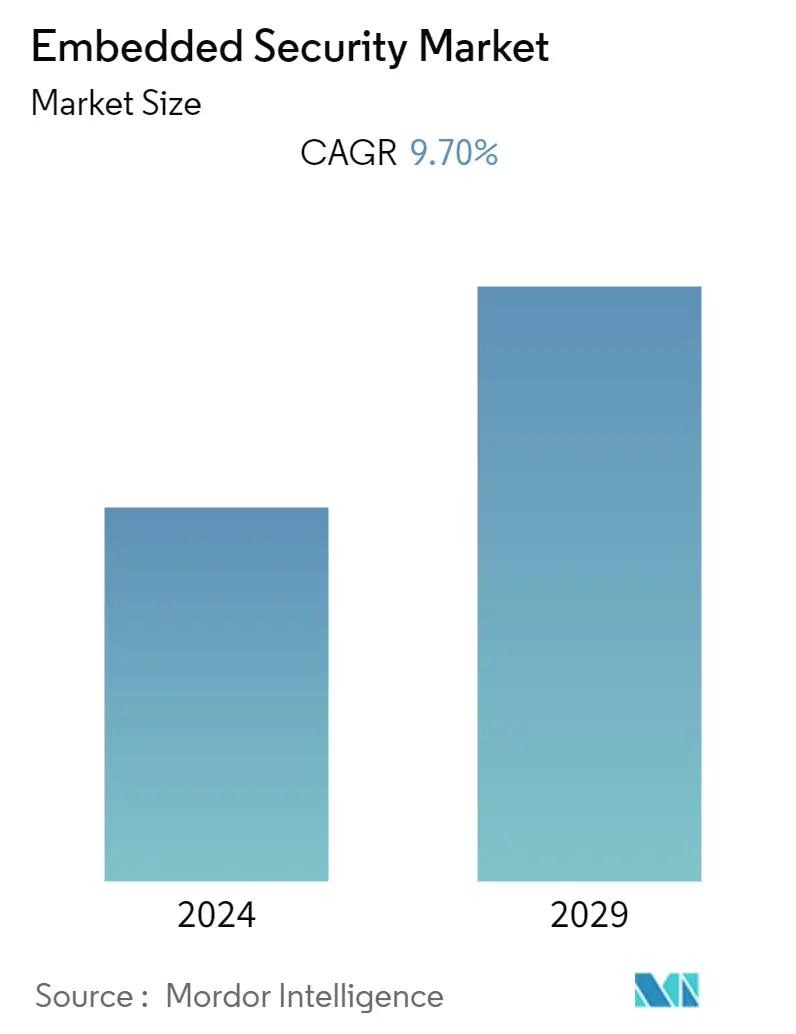Market Size of Embedded Security Industry

| Study Period | 2019 - 2029 |
| Base Year For Estimation | 2023 |
| CAGR | 9.70 % |
| Fastest Growing Market | Asia Pacific |
| Largest Market | North America |
| Market Concentration | Low |
Major Players
*Disclaimer: Major Players sorted in no particular order |
Need a report that reflects how COVID-19 has impacted this market and its growth?
Embedded Security Market Analysis
The Embedded Security Market is expected to register a CAGR of 9.7% over the forecasted period. The increasing need for embedded security solutions in various applications such as wearables, smartphones and tablets, automotive, smart identity cards, industrial, payment processing and cards, and computers are driving the growth of this market. Furthermore, the burgeoning Bring Your Own Device (BYOD) trend is boosting global demand for embedded security solutions.
- Further, to safeguard the processing and cardholder data, embedded security is implemented. The usage of embedded security serves to reduce the danger of data breaches, which can result in financial losses and reputational damage. It also aids in meeting the criteria of the Payment Card Industry Data Security Standard (PCI DSS). Secure elements, Trusted Execution Environment (TEE), and tamper-resistant hardware is examples of embedded security used in payment processing and cards. These embedded security solutions prevent cardholder data from being compromised by attackers, among other things.
- Technology is advancing faster than ever before. Every day, technology advances and introduces new approaches and functions. It is not just about computers and mobile applications. It is all about artificial intelligence and Internet of Things-based gadgets, widely employed in everyday human life. The rise of IoT is spreading across all industry sectors. It is utilized in various applications, including industrial automation, healthcare equipment, aviation, wearable technologies, smart home units, automobiles, and others. The growing use of IoT raises the possibility of different security vulnerabilities with connected devices. This also raises the likelihood of external cyber threats attacking running systems, causing the device to malfunction and cause harm. Also, embedded security devices are on the rise to avoid this condition.
- The market for electric vehicles is constantly evolving and maturing. Customers are aggressively seeking vehicles that do not use traditional fossil fuels. These vehicles should be both cost-effective and environmentally beneficial. Also, to meet these needs, an increasing number of electric charging stations must be established in homes and roadways. This charging station's security is vital to protect its critical infrastructure. The complicated design and multiple safety concerns in electric vehicles and charging points make managing all security challenges in the system tough. Embedded device security systems help with this problem. Electric vehicle security is critical due to cars' rising quantity of embedded and connected software.
- Furthermore, the Mastercard New Payments Index report indicated that 94% of Saudi Arabian consumers would consider using at least one emerging payment method, such as cryptocurrency, biometrics, contactless, or QR code, in the last year. Furthermore, 68% of respondents reported trying a new payment method, which they wouldn't have under normal circumstances. The COVID-19 pandemic has pushed the country's population to try alternative payment methods and reap the benefits of timeliness and convenience. This would have affected the studied market positively.
- This system has gained popularity in recent years. However, the basic cost of a single physical security device plus a communication security device is more than the cost of a traditional security system. Internal components like transmitters, receivers, and sensors utilized in security systems are more expensive, directly impacting the system's primary selling price. Furthermore, renewing existing security systems and adopting new integrated technology is not cost-viable for SME enterprises and individual users.
